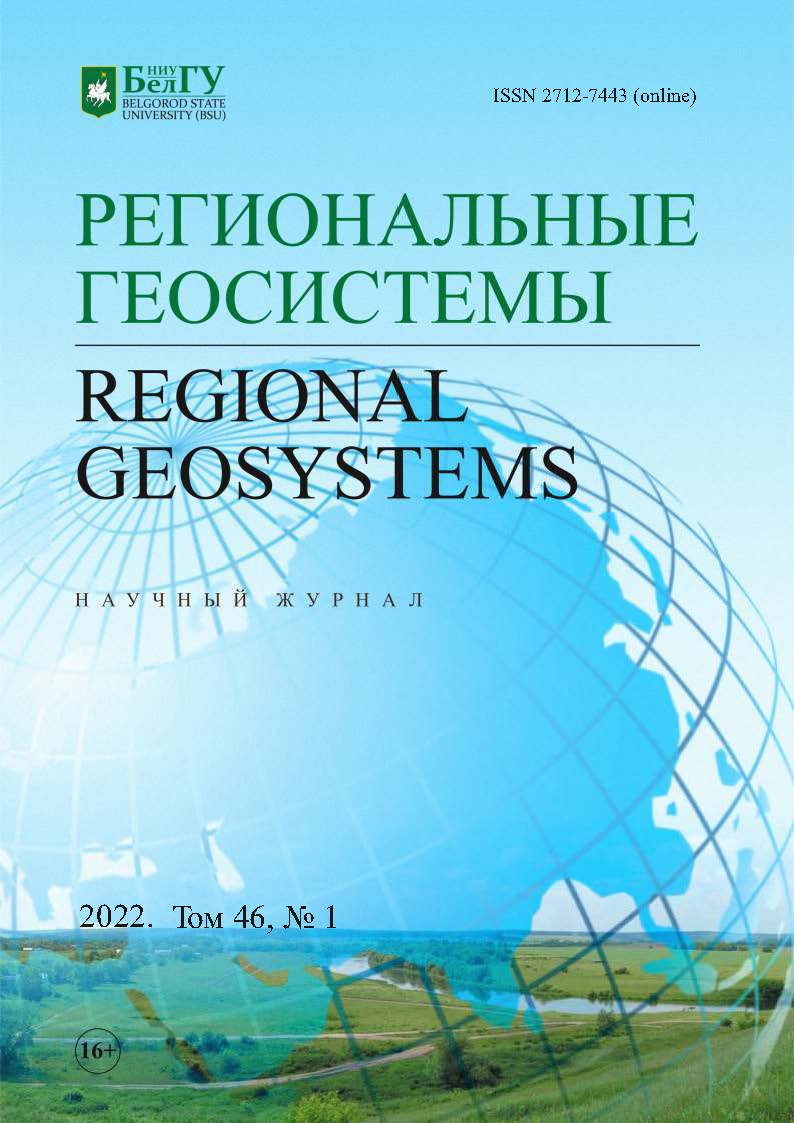Morphological diversity of the upper reaches of the Desna River
DOI:
https://doi.org/10.52575/2712-7443-2022-46-1-81-93Keywords:
macromeanders, factors of the riverbed process, morphologically homogeneous flow segments, geological and geomorphological structure of the valley, upper course of the Desna riverAbstract
The article describes the morphological diversity of the upper reaches of the Desna River at the level of large sections of the current. The catchment area and the valley of the Desna River is distinguished by a great variety of relief and geological structure, which is manifested both in modern riverbed processes and the morphology of the riverbed. It is noted that the epochs of high costs can be traced in the configuration of the modern channel, and the most studied consequence of high costs is the formation of macromeanders. Large, morphologically homogeneous sections of the current are considered as the level of organization of the forms of riverbed relief. It is assumed that morphological differences reflect the influence of individual factors on the intensity and direction of riverbed processes. At the same time, the methodological foundations of the study of this level of riverbed relief are considered schematically in the domestic and foreign literature. The article presents the results of studying morphologically homogeneous segments of the upper reaches of the Desna River. The methodological foundations of the identification and description of large sections of the flow as a level of organization of the channel relief are given. The great importance of geological and geomorphological factors in the isolation of morphologically homogeneous sections of the riverbed, including in epochs of expenditures significantly exceeding modern values, is substantiated. The information about the morphological characteristics of large sections of the flow is presented, their typology is given. The mechanisms of the influence of the structure of the valley and the catchment area on the isolation of morphologically homogeneous flow segments are consider.
Downloads
References
Герасимов И.П., Величко А.А. 1982. Палеогеография Европы за последние сто тысяч лет: Атлас-монография. М., Наука, 156 с.
Лобанов Г.В., Синицина Е.В. 2019. Влияние различий геологического строения на морфологию русел малых и средних рек бассейна верхнего Днепра. В кн.: Закономерности проявления эрозионных и русловых процессов в различных природных условиях. Материалы V Всероссийской научной конференции с международным участием, 3–6 сентября 2019, Москва, Ленанд: 286–287.
Лобанов Г.В., Зройчикова О.А., Полякова А.В., Сабайда Е.А., Новикова М.А., Тришкин Б.В. 2013. Геолого-геоморфологические факторы структуры и динамики флювиальных систем в бассейне верхнего Днепра. Вестник Томского государственного университета, 373: 189–197.
Лобанов Г.В., Зверева А.Ю., Протасова А.П., Тришкин Б.В., Новикова М.А., Полякова А.В. 2020. Геоморфологическое районирование на основе цифровых моделей рельефа (по данным SRTM для верхнего Поднепровья). Геоморфология, 3: 44–55. DOI: 10.31857/S0435428120030074.
Лобанов Г.В., Зуева Е.В., Жохов М.В. 2021. Факторы морфологического разнообразия русла верхней Десны. В кн.: Тридцать шестое пленарное межвузовское координационное совещание по проблеме эрозионных, русловых и устьевых процессов. Доклады и краткие сообщения, 11–15 октября 2021, Ижевск, Удмуртский университет: 122–124.
Марков К.К. 1965. Четвертичный период (Ледниковый период – антропогеновый период): К VII Международному конгрессу Ассоциации по изучению четвертичного периода (ИНКВА). М., Издательство Московского университета, 371 с.
Матлахова Е.Ю. 2021. Макроизлучины реки вороны как свидетельства мощного речного стока в позднеледниковье. Вестник Московского университета. Серия 5: География, 2: 103–109.
Панин А.В., Сидорчук А.Ю. 2006. Макроизлучины ("большие меандры"): проблемы происхождения и интерпретации. Вестник Московского университета. Серия 5: География, 6:14–22.
Панин А.В. 2015. Флювиальное рельефообразование на равнинах умеренного пояса Евразии в позднем плейстоцене – голоцене. Автореф. дис. … док. геогр. наук. М., 46 с.
Природные ресурсы и окружающая среда субъектов Российской Федерации: Брянская область. 2007. Под ред. Н.Г. Рыбальского, Е.Д. Самотёсова, А.Г. Митюкова. М., НИА-Природа, 1144 c.
Русловедение: теория, география, практика. 2008. Под ред. Р.С. Чалова. М., URSS, 607 c.
Сидорчук А.Ю., Панин А.В. 2017. Геоморфологические подходы к оценке величины речного стока в геологическом прошлом (ст. 1. морфометрические зависимости). Геоморфология, 1: 55–65. DOI: 10.15356/0435-4281-2017-1-55-65
Сидорчук А.Ю., Украинцев В.Ю., Панин А.В. 2021. Оценка годового стока Волги в позднеледниковье по данным о размерах палеорусел. Водные ресурсы, 48 (6): 643–655. DOI: 10.31857/S0321059621060171.
Смирнова Е.А., Лобанов Г.В., Бастраков Г.В. 2009. Влияние прочностных характеристик грунтов на интенсивность русловых деформаций в среднем течении р. Десны. Геоморфология, 2: 75–83.
Чалов Р.С., Завадский А.С., Панин А.В. 2004. Речные излучины. М., МГУ, 371 с.
Чернов А.В. 2020. Морфология и голоценовая эволюция поймы реки Москвы в Нижнем течении. Географический вестник, 1 (52): 60–70. DOI: 10.17072/2079-7877-2020-1-60-70.
Bollati, I.M., Pellegrini L., Rinaldi M., Duci G., Pelfini M. 2014. Reach-scale morphological adjustments and stages of channel evolution: The case of the Trebbia River (northern Italy). Geomorphology, 221: 176–186. DOI: 10.1016/j.geomorph.2014.06.007.
Falkowski T., Ostrowski P., Siwicki P., Brach M. 2017. Channel morphology changes and their relationship to valley bottom geology and human interventions; a case study from the Vistula Valley in Warsaw, Poland. Geomorphology, 297: 100–111. DOI: 10.1016/j.geomorph.2017.09.011.
García J.H., Ollero A., Ibisate A., Fuller I.C., Death G., Piégay H. 2021. Promoting fluvial geomorphology to “live with rivers” in the Anthropocene Era. Geomorphology, 380: 107649. DOI: 10.1016/j.geomorph.2021.107649.
Kondolf G.M., Piégay H., Schmitt L., Montgomery D.R. 2016. Geomorphic classification of rivers and streams. Tools in Fluvial Geomorphology, 133–158. DOI: 10.1002/9781118648551.ch7.
Nardini A, Brierley G. 2021. Automatic river planform identification by a logical-heuristic algorithm. Geomorphology, 375: 107558. DOI: 10.1016/j.geomorph.2020.107558.
Ostrowski P., Falkowski T., Utratna-Żukowska M. 2021. The effect of geological channel structures on floodplain morphodynamics of lowland rivers: A case study from the Bug River, Poland. CATENA, 202: 105209. DOI: 10.1016/j.catena.2021.105209.
Rinaldi M., Surian N., Comiti F., Bussettini M. 2015. A methodological framework for hydromorphological assessment, analysis and monitoring (IDRAIM) aimed at promoting integrated river management. Geomorphology, 251: 122–136. DOI: 10.1016/j.geomorph.2015.05.010.
Abstract views: 251
Share
Published
How to Cite
Issue
Section
Copyright (c) 2022 REGIONAL GEOSYSTEMS

This work is licensed under a Creative Commons Attribution 4.0 International License.


